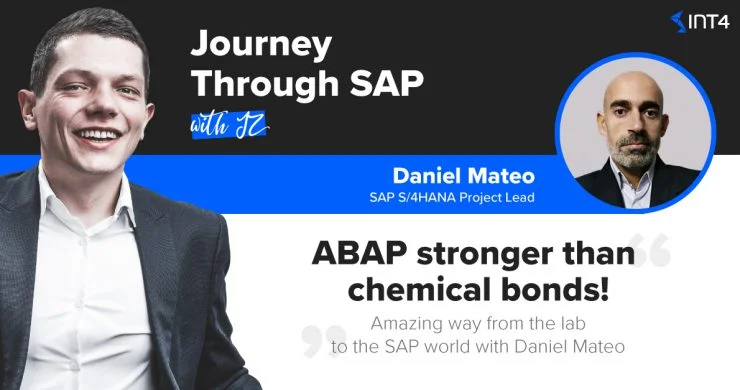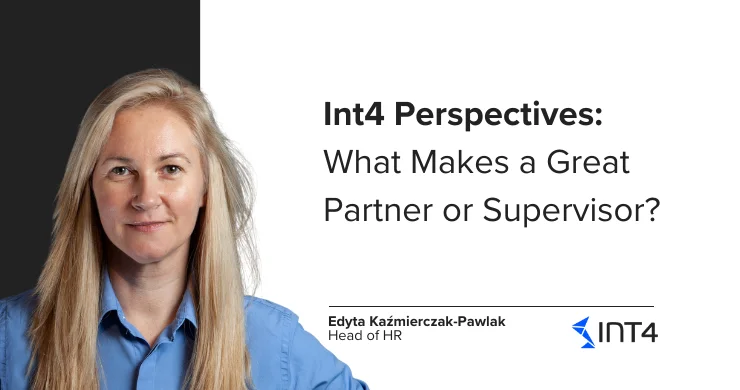ABAP stronger than chemical bonds! Amazing way from the lab to the SAP world with Daniel Mateo

Let me introduce my guest
My today’s guest has over 12 years experience in financial accounting and controlling modules (FICO). He also holds several professional certifications as well; such as SAP Activate Project Manager, SAP S/4HANA Financial Accounting, Project Manager Professional (PMP). He managed S/4HANA Greenfield implementation, seven SAP Rollouts in America, eight in Europe, and one global Upgrade.
About the most common mistakes in S/4HANA projects, the use of AIF in SAP FICO scenarios and work in international, multicultural environments – Daniel Mateo is interviewed by Jarosław JZ Ziółkowski.
Reading time: 5 minutes
1. You have more than a decade of experience in the SAP industry. How did your beginnings look like?
I started in the SAP industry in February 2008, after finishing the Degree in Chemical Engineering at 23 years old. Although my background was not related to IT, I was motivated with this area to apply analytical skills to solve complex problems. Then, at that time, I joined an IT Consulting firm that looked for freshers to be trained in the SAP software, to start as an ABAP consultant. After the initial training, I was assigned to a project within the public sector for hyper care support after Go-Live. I did some effort working several hours’ overtime, but it was worth it to improve my knowledge and being focused to grow up as a Functional Consultant. I have many good memories, and I still keep some friends from that great experience.
Based on my experience, I always recommend IT freshers to put some effort into learning new skills, to have further opportunities in the current demanding job market.
2. What is your role now?
Currently, I am participating as Project Manager in an SAP S/4HANA implementation with the primary goal for automating the billing processes from headquarters offices to its related subsidiaries and franchise owners. I am working as a contractor for one of the Big Four consultancy firms.
That assignment is a challenging project that requires a firm understanding of the business’s flows since it affects the core processes of the multinational customer. It includes branches all around the world with different time zones and traditions that allow them to grow up in multicultural environments.
3. When it comes to the S/4 HANA, what do you think are the most common mistakes in S/4 HANA projects, and how can you avoid them?
One of the common mistakes in an SAP S/4HANA project, likewise other IT projects, is not to understand or discuss the needs of the business stakeholders properly to set the requirements. It is essential in this process to acknowledge the available functionalities that the system has to define how the operations will be covered with the new solution.
Another common mistake is to presume some processes in the new solution without involving or informing the key users about that. Then, misconceptions may arise during the user acceptance phase. At that time it could be late to adjust these processes as expected.
In order to avoid these issues, it is essential to periodically organize workshops with the business stakeholders to keep them involved and discuss each of the processes using a demo in the new system to be aligned with the requirements. The communication with all the participants involved in the project is key for a successful implementation.
4. Let’s stay on the subject of S/4HANA for a while. Do you think there is any way to automate testing of S/4HANA conversions projects?
Currently, there are several tools to create test cases to consider different scenarios to run them in the SAP S/4HANA system afterwards. However, in most of them, it is a time-consuming task to create and adjust the different situations required, and a mix of various tools are used. Then, sometimes the test cases are not updated correctly, and the tests may not be processed very efficiently.
It would be nice to have a tool to reduce the time of maintaining and executing the tests while communicating the results and the degree of advance efficiently to the business stakeholders to keep them involved in this important phase.
5. Going through your LinkedIn profile, I have noticed that you have many certificates – not only in the SAP area. I’m wondering, which of them was the most difficult to get. Which one you think might be most useful in your work?
I consider that it is essential to have certifications to validate that you have knowledge in this area and understand the crucial points of the corresponding processes or methodologies. The knowledge acquired in each of the certifications, together with the previous professional experiences allows us to apply the best approach to focus on any process of SAP implementation. I consider that each of the certifications is useful in its area, and no ones are more important than the others. Just to understand when can be applied to each section of the knowledge in the daily tasks.
One of the most demanding certifications to obtain was the PMP since it requires to understand the inputs and outputs for each of the knowledge areas and how they can be used efficiently.
6. Concerning your skills, have you ever worked with machine learning, Leonardo in SAP?
I took some courses related to Machine Learning and SAP Leonardo since with the volume of data currently available and the performance of the systems, they are potent tools. With them, the main processes can be automatized, reducing the manual tasks and improving the response time in a fast paced environment. However, I am not having any professional experience with this type of technology, although I will be glad to participate in some related project.
7. Okay, last technical question for today. Can you describe how AIF is used in SAP FICO S/4HANA scenarios?
I used the SAP Application Interface Framework (AIF) while implementing the Electronic invoicing in Italy through the SDI system (Sistema di Interscambio). In this case, the framework converts with SAP standard mappings the sales and finance invoices into the country-specific format covering the Italian legal requirements. The communication with the legal agency was done afterwards through the SAP Cloud Platform Integration (CPI).
AIF has further functionalities such as defining own mappings for specific processes, for instance, sending a customized template to a customer once the billing is executed. That also offers simplified monitoring across interfaces and configuring alerts to involve business users. While tracking, it is possible to protect sensitive fields or structures.
8. What is ahead of you, are you planning to write an SAP PRESS book?
In the upcoming years, I am not planning to write any book, since it requires lots of dedication and time. Nevertheless, I don’t discard this idea in the long-term. What’s worthy to say, I would like to participate in global S/4HANA international projects that allow me to grow professionally, leading teams to meet objectives and to improve relevant financial and logistics processes while applying strong analytical skills. That is how I see the upcoming future.
Read also
1. She knows how to bite the bullet! Spanish bullfighter in the SAP world – interview with Isabel Sanchez.
2. “A toolbox instead of a Swiss army knife” SAP integration world through Pontus eyes – interview with Pontus Borgstrom.
Popular tags
ABAP int4 INT4 IFTT Int4Interview S/4HANA SAP AIF SAP CPI sap integration


